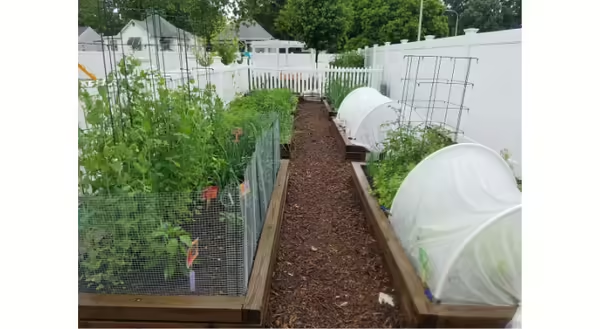
In last week’s blog, I covered the basics of site selection for a new vegetable garden. Finding the best location in your yard, or understanding that containers may be the winning option is a really important part of setting up your growing space for success. I would like to continue the discussion this week by taking a closer look at the growing medium, or soil, we choose for gardening.
Whether it is an area of lawn or an existing garden space that you are considering for your veggie patch, the underlying soils are an incredibly important aspect. One of the first considerations is drainage, which relates to a soils ability to remove excess water. In an urban setting, many soils are compacted from foot traffic, mowing or other common activities. Compaction increases soil density while reducing the soil’s ability to convey excess water.
Many times, you may already be able to identify poorly drained areas of your yard from the presence of surface water during heavy rains. Other times highly compact areas aren’t so obvious until you dig in and start to plant. Try digging a test hole in your potential garden location to take closer look at the soil. It doesn’t have to be very deep, a simple 12-inch diameter hole that is a 8-12 inches deep can really paint the picture.
It’s safe to say that darker soils have a higher organic matter content and will support plant life better. In addition, a quality soil will have a nice even color as opposed to a mixture of colors. Observe the soil coming out of your test hole, as well as the sidewalls of the hole. Does it appear to be an evenly dark-colored soil or a mixture of soil colors with lighter brown to tan colors? A mixture of colors is a good sign your soil was disturbed by some past human activity and may not be productive or drain well.
A disturbed or unproductive soil can be easily amended with compost. Compost is readily available in bagged form at most garden centers or in larger quantities at local landscape recycling centers. The City of Urbana has a wonderful facility that provides an excellent compost product at a very low price. Incorporating compost into the soil, either by borrowing your neighbor’s tiller or hand shoveling, will boost the organic matter content and create a more productive garden soil.
A raised bed is a great solution for areas that are poorly drained or lack productivity. There are a variety of materials that can be used to construct your raise bed, from untreated lumber to something as simple as tree limbs or some old bricks, but be sure to use materials that will not leach harmful chemicals into the soil. It doesn’t have to be fancy, it just has to hold back some soil.
Raised beds should be filled with a productive growing medium consisting of about 1/3 compost and 2/3 soil. You can easily purchase bagged “garden soil” at most garden centers or larger quantities at landscape recycling centers.
Testing your soil prior to planting is a highly recommend practice and is not nearly as big of deal as it sounds. Many folks really stress out at the mention of a lab soil test, but you can actually learn a lot with a small investment both money and time. Locally, there are a number of accredited soil testing labs, all of which offer tests specific to vegetable gardening. Contact a local soil testing lab for more information, they are wealth of knowledge and provide consultation on next steps after you receive your results.
If all of this talk of soils and digging seems like too much or you just don’t have space, maybe a few containers would be a good start this year? You should always use a soilless potting mix, commonly referred to as “potting soil” for container gardening. Naturally formed soils don’t perform well in containers for a variety of reasons.
Be sure your containers are made of safe materials because some, such as treated lumber, painted or glazed pots, and metal containers, can leach harmful contaminants into the soil. Containers can be purchased pre-made or constructed from a variety of materials you may already have around. If you make your own, be sure to add plenty of drainage holes to the bottom.
Please join me next week as I explore the next steps in a new vegetable garden establishment with a discussion of plants in the garden.